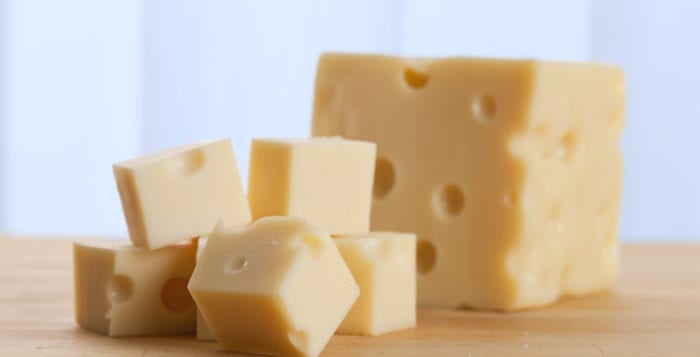Wine & Cheese: Swiss cheese really doesn’t exist!
By Bob Lipinski
“What is a harp but an oversized cheese slicer with cultural pretensions?”
— Denis Norden, English comedy writer
 “Swiss cheese” as we know it doesn’t really exist. It is a generic term often used in North America for any type of cheese, regardless of where it comes from, as long as it has a pale-yellow body and is literally full of holes or “eyes,” with a rubbery texture. And this holds true for both imported and “domestic” Swiss cheeses.
“Swiss cheese” as we know it doesn’t really exist. It is a generic term often used in North America for any type of cheese, regardless of where it comes from, as long as it has a pale-yellow body and is literally full of holes or “eyes,” with a rubbery texture. And this holds true for both imported and “domestic” Swiss cheeses.
Most of the time the cheese is actually Emmentaler from Switzerland or Jarlsberg from Norway. In the UK and Europe, the term Swiss cheese has no meaning and asking for a “pound of Swiss cheese” would be the equivalent of saying, “I’d like a pound of Italian cheese” in Italy, whereby Italians would ask, “Which Italian cheese?”
Switzerland produces more than 450 varieties of cheese (mostly from cow’s milk) and they are not all called “Swiss Cheese.” Emmentaler, a cow’s milk cheese comes from the Emme Valley (near Bern), Switzerland, where it has been made since the fifteenth century. It has a pale-yellow exterior with large shiny holes and a natural edible rind; light yellow interior and is wheel-shaped. It is firm to very firm; with an almost elastic, smooth, plastic texture and slightly oily. Emmentaler is mild to full-flavored, with a sweet, fruity, nutty flavor. A younger and milder version is known as Baby Swiss. Genuine Swiss Emmentaler has the word “Switzerland” stamped all over the rind.
By the way, the holes in the cheese are produced by carbonic acid gas bubbles during fermentation or bacterial activity, which generates propionic acid and causes gas to expand within the curd also creates the holes. The bubbles are unable to escape, which is responsible for the “hole” formation ranging from pinhead size to dime or quarter size. They are sometimes made mechanically for appearance sake. Before serving the cheese, allow it to sit for 30 minutes to one hour at room temperature, which will soften the texture, release the aromas and maximize the flavor.
Now my wine recommendations:
2015 Torre Santa La Rocca “Bombino Nero” Rosé (Italy): Salmon color with an intense fruity bouquet of cherry, strawberry and melon. Dry and quite flavorful; citrus, orange and raspberries abound. Great for Sunday brunch.
2012 Château Prieurs de la Commanderie (Pomerol, Bordeaux): (80 percent merlot/ 20 percent cabernet franc). Bouquet and flavor of black cherry, plums and cedar. Medium-bodied, quite smooth and very easy to drink now or in a few years. I think of lamb chops rubbed with rosemary.
2014 Komodo Dragon “Red Blend” Columbia Valley, Washington: Quite dark with a full bouquet and flavor of black currants, black cherries, chocolate and licorice. Hints of nutmeg, cinnamon, coffee and vanilla. Pair this with a porterhouse steak.
Bob Lipinski, a local author, has written 10 books, including “101: Everything You Need to Know About Whiskey” and “Italian Wine & Cheese Made Simple” (available on Amazon.com). He conducts training seminars on wine, spirits and food and is available for speaking engagements. He can be reached at www.boblipinski.com OR [email protected].







